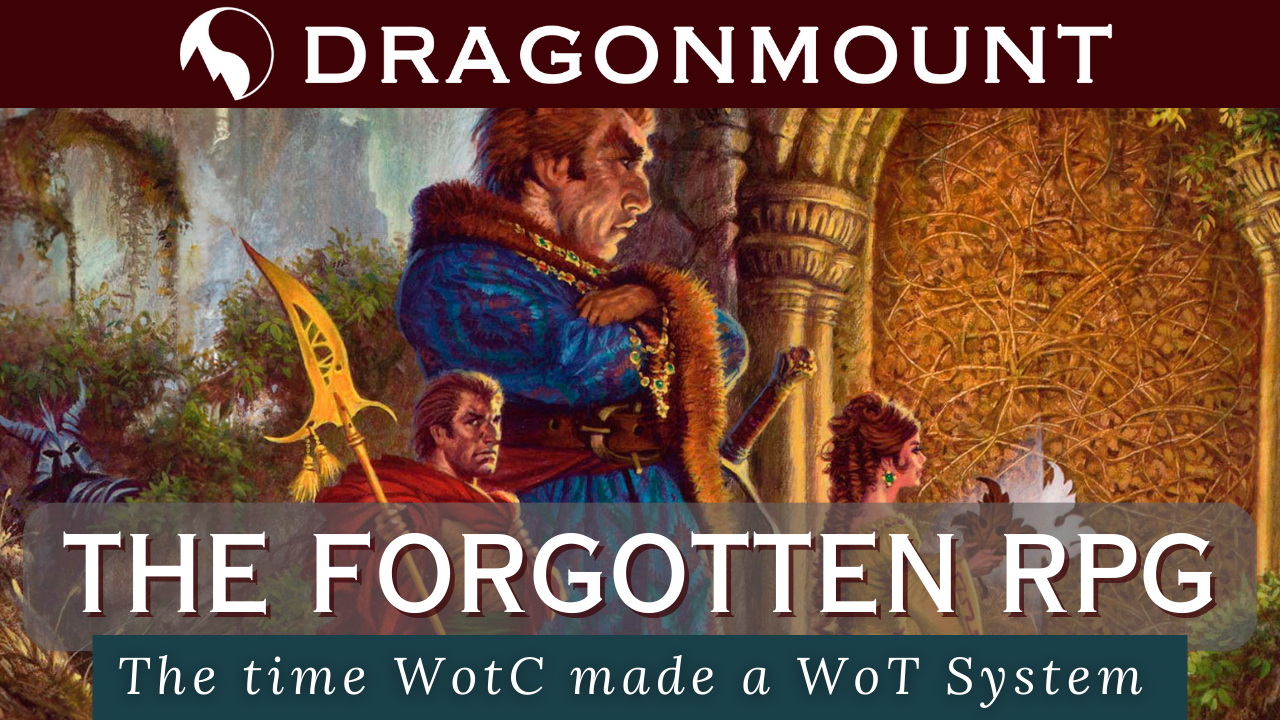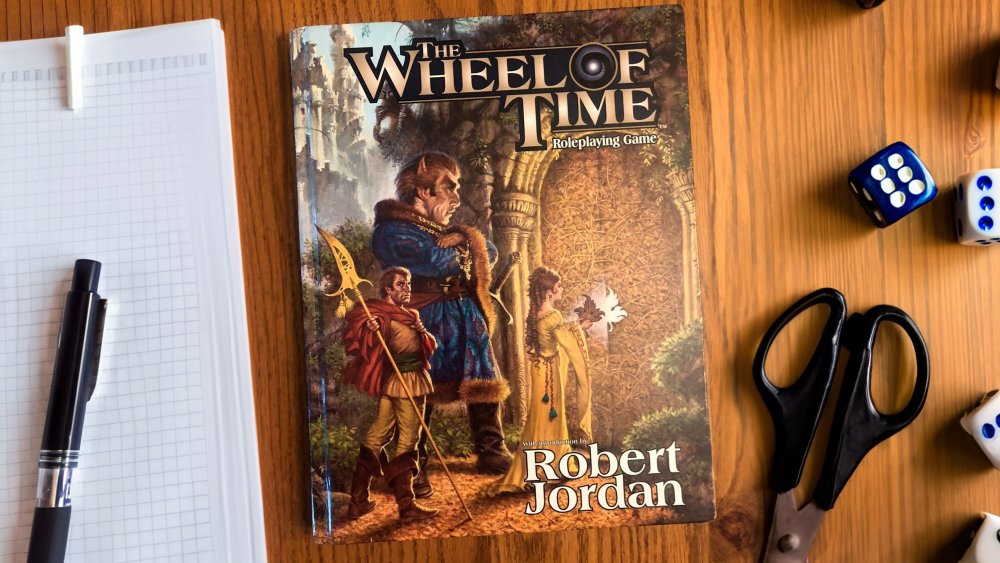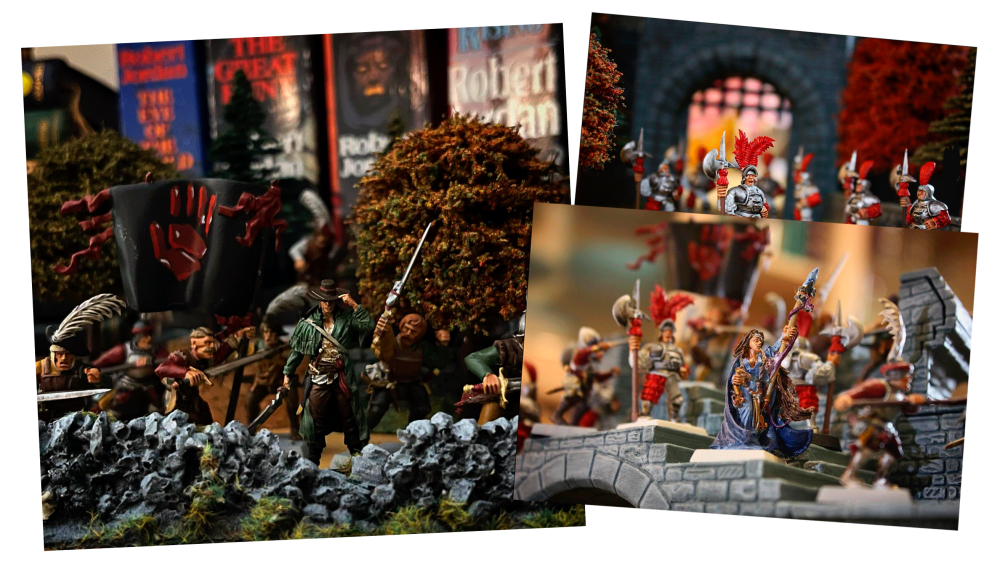
I Rolled a 20 on the Random Article table.
Ah, the Wheel of Time, a tapestry of epic proportions spun by the brilliant Robert Jordan. It's a world we've all come to adore, one that has touched our souls with its grandeur. But I have never entered it so deeply as when I first played a RPG session set in the lands of the Dragon Reborn.
Bienvenidos, my fellow travelers, to an article about the Wizards of the Coast Wheel of Time Roleplaying Game, a forgotten game that has recently resurfaced into my mind and that I believe both old aficionados and curious newcomers will find just as amusing as myself.
Why write about it now?
Personally, I find it intriguing to see how different people deal with Jordan's work, just as Rafe is doing and Brandon has done in the past. Some things in this book are just as interesting to analyze. Whether you're an old fan or a curious newcomer, the Wheel of Time RPG offers a chance to experience Jordan's world in a different way. Even if this way is through the lens of 2000s game designers not as well versed in Jordan’s universe as us diehard fans.
As I revisit this unique RPG, I realize that some of the first images and art from the series I saw came from it, something I didn't remember at all. The first image of an Ogier that I experienced came from this book, and I only realize it now by revisiting it. Maybe that's also the case for some of you. This alone is another reason to go through it once more. Something I catch myself doing from time to time since I grabbed a copy of this book in Auckland when I was visiting my uncle.
In my opinion, every adaptation is interesting. And it's even cooler to look at them after a new one comes out. No matter how different the media are, it's something that always catches my attention. As we can see on the internet every day: No one would do things the same way and everyone has their own perfect adaptation in mind. So why don't we collectively step into the minds of those who made this game over two decades ago?

The Creators of the System.
Crafted during the heyday of the D20 movement in tabletop RPGs, and at a time when fresh Wheel of Time content was in short supply, this publication undeniably satisfied the cravings of series enthusiasts. Nevertheless, it falls short in terms of the depth and replayability that could have transformed it from a mere novelty.
The 300+-page rulebook featured new and original art throughout, bringing the world of The Wheel of Time to the tabletop. As a short book, it does its best at trying to condense the vast world of Robert Jordan into a few pages, sometimes making its depiction of the setting feel broad and lacking in detail.
The game was based on the D20 rules system used by the third edition of Dungeons and Dragons, following a similar layout and format to the D&D core rulebooks despite all the setting differences.
It was penned by a veteran designer team, including Charles Ryan, Steven Long, Christian Moore, and Owen K.C. Stephens. It's noteworthy that Robert Jordan himself provided a foreword for the game, revealing his own connection to the world of tabletop gaming and his excitement for the Wheel of Time RPG.
The Wheel of Time RPG incorporated the talents of Darrell K. Sweet, the artist for the novels, who provided the cover artwork. It is so cool to see two additional paintings from him in the world of WoT that are not covers of the novels. It evokes a feeling of something familiar, but new at the same time, since not everyone has had contact with these illustrations.
A large number of Wizards of the Coast artists contributed additional illustrations throughout the book, adding depth to the gaming experience. Ellisa Mitchell, known for providing cartographic services on the novels, created several new maps for the rulebook. Again, some of them that I had no idea were created specifically for this.
D&D or not to be?
This game made a lot of changes to the core D&D mechanics. The standard D&D character classes were replaced by new ones, such as Aiel spear-carriers, Armsman, Initiate (in the Aes Sedai or Asha'man), Noble, Wanderer, Wilder, and Woodsman. Multiclassing was also an option since this was a d20 system.
Much like D&D 3rd Edition, feats played a significant role in character creation. Specialist feats for the use of the absolutely game breaking One Power were introduced, along with Feats that allowed players to replicate unique abilities from the books.
The rulebook delved into the setting and history of The Wheel of Time, drawing from the novels that were published at the time. It offered somewhat comprehensive information, including the founding circumstances of countries like the Borderlands, Cairhien, Illian, Tarabon, and Tear during the War of the Hundred Years. But it went out of its way to avoid topics that would be discussed in future books written by Jordan.
Later in his blog, Robert Jordan talked about the process of helping in the concept of the game, wanting to do more but with no time because of the books. And how he managed to avoid items
The book featured re-drawn, full-color, and larger-scaled maps of cities like Ebou Dar, Caemlyn, Cairhien, and Tar Valon, adding a visual dimension to the gaming experience. An introductory adventure titled 'What Follows in Shadow' was included, set during the events of "The Eye of the World," offering players an immersive starting point for their own Wheel of Time adventures.
It's always a challenge to create a game that takes place during the events of an ongoing story, but sometimes it's difficult to take agency away from the players because they're doing something that conflicts with the original canon or that wouldn't make sense in the world.
The Lord of the Rings RPG, The One Ring, fails greatly in this aspect, where adventurers can only do the minimum without entering territory that threatens the original story of the books. Fortunately, this is not something that happens in the Wheel of Time RPG. Adventures offer options and stories that don't affect the book arcs and still have meaning for players.
An expansion was created for the game called "The Prophecies of the Dragon," which is the only expansion to The Wheel of Time Roleplaying Game that was published. Again, cartography was handled by Ellisa Mitchell, and a new cover was produced by Darrell K. Sweet. Robert Jordan is listed as a creative consultant.
Photos by: @manetheren_miniatures
An invitation
This is not a review (although if there is enough interest it might as well be in the future), but an invitation for fans to take a closer look at this material and appreciate its unique aspects. It's a journey through the past, a chance to rediscover something that may have been forgotten in the midst of new adaptations. As a fan, I felt compelled to revisit this piece of Wheel of Time history and share its significance. Even if my only conclusion is: Maybe it's time to try again.
In the same vein, I plan to explore other forgotten media and adaptations related to the Wheel of Time universe, like for instance the PC first-person boomershooter reminiscent of Quake and any other turning of the wheel that I can lay my nerdy hands on.
But what now?
The recent television adaptation of The Wheel of Time series on Amazon Prime has reignited interest in this classic RPG. As fans of the TV series dive deeper into the lore, some are discovering the tabletop game and finding themselves drawn into the enchanting world of Aes Sedai and Trollocs. Which poses the question: Is it time for a new Wheel of Time Tabletop RPG?
Some fans believe so. As part of the show's 1st and 2nd season promotional material, Prime Video Brazil conducted two different RPG sessions with YouTubers from the country. But these sessions were based on existing systems and seemed more like a patchwork than something designed for WoT. We also had fan adaptations for D&D 5e, but nothing official has been released since these two books in the early 2000s. Perhaps it's time for new materials to come.
With numerous RPGs emerging every year and new design philosophies being introduced, such as in games like Mörk Borg, Knave, Shadowdark and many others, and with RPGs making a comeback in mainstream media with shows like Stranger Things, I see no reason not to have a new adaptation of Jordan's world for tabletops. Certainly, fans would love it, especially now that the hobby is more popular than ever.
- bkwrm79, WheelofJuke and Shawlee
-
 3
3













Recommended Comments
Join the conversation
You can post now and register later. If you have an account, sign in now to post with your account.
Note: Your post will require moderator approval before it will be visible.